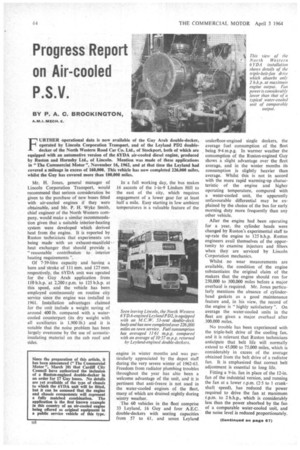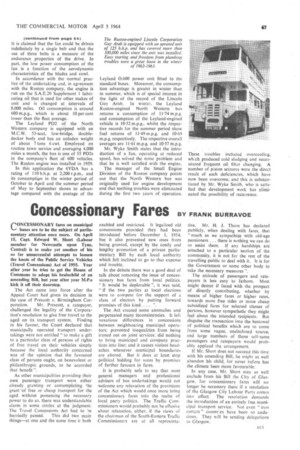Progress Report on Air-cooled P.S.V.
Page 66

Page 69

If you've noticed an error in this article please click here to report it so we can fix it.
BY P. A. C. BROCKINGTON, A.M.I. MECH. E.
FURTHER operational data is now available of the Guy Arab double-decker, operated by Lincoln Corporation Transport, and of the Leyland PD2 doubledecker of the North Western Road Car Co. Ltd., of Stockport, both of which are equipped with an automotive version of the 6YDA air-cooled diesel engine, produced by Ruston and Hornsby Ltd., of Lincoln. Mention was made of these applications in "The Commercial Motor ", November 16, 1962, and at that time the Leyland had covered a mileage in excess of 160,000. This vehicle has now completed 226,000 miles, whilst the Guy has covered more than 100,000 miles.
Mr. H. Jones, general manager of Lincoln Corporation Transport, would recommend that serious consideration be given to the purchase of new buses fitted with air-cooled engines if they were obtainable, and Mr. P. H. Wyke Smith, chief engineer of the North Western company, would make a similar recommendation given that a suitable interior-heating system were developed which derived heat from the engine. It is reported by Ruston technicians that experiments are being made with an exhaust-manifold • heat exchanger that should provide a "reasonable contribution to interior heating requirements ".
Of 7.39-litre capacity and having a bore and stroke of 111 mm. and 127 mm. respectively, the 6YDA unit was uprated for the Guy Arab application from 110 b.h.p. at 2,200 r.p.m. to 125 b.h.p. at this speed, and the vehicle has been employed continuously on routine city service since the engine was installed in 1961. Installation advantages claimed for the unit include a weight saving of around 400 lb. compared with a watercooled counterpart (its dry weight with all auxiliaries is 1,900 lb.) and it is notable that the noise problem has been largely overcome by the use of acousticinsulating material on the cab roof and sides.
In a full working day, the bus makes 16 ascents of the l-in-9 Lindum Hill to the east of the city, which requires engagement of a lower gear for at least half a mile. Easy starting in low ambient temperatures is a valuable feature of the
engine in winter months and was particularly appreciated by the depot staff during the very severe winter of 1962-63. Freedom from radiator plumbing troubles throughout the year has also been a welcome advantage of the unit, and it is pertinent that anti-freeze is not used in the water-cooled engines of the fleet, many of which are drained nightly during wintry weather.
The 60 vehicles in the fleet comprise 33 Leyland, 16 Guy and four A.E.C. double-deckers with seating capacities from 57 to 61, and seven Leyland
underfloor-engined single deckers, the average fuel consumption of the fleet being 9-4 m.p.g. In warmer weather the consumption of the Ruston-engined Guy shows a slight advantage over the fleet average, and in the winter months its consumption is slightly heavier than average. Whilst this is not in accord with the more rapid warming-up characteristic of the engine and higher operating temperature, compared with a water-cooled unit, the apparently unfavourable differential may be explained by the choice of the bus for early morning duty more frequently than any other vehicle.
After the engine had been operating for a year, the cylinder heads were changed by Ruston's experimental staff to up-rate the engine to 125 b.h.p. Ruston engineers avail themselves of the opportunity to examine injectors and filters when they are serviced by Lincoln Corporation mechanics.
Whilst no wear measurements are available, the condition of the engine substantiates the original claim of the makers that the engine should run for 250,000 to 300,000 miles before a major overhaul is required. Mr. Jones particularly mentions the absence of cylinderhead gaskets as a good maintenance feature and, in his view, the record of the engine is "highly satisfactory ". On average the water-cooled units in the fleet arc given a major overhaul after 300,000 miles.
No trouble has been experienced with the triple-belt drive of the cooling fan, and it is relevant that Ruston technicians anticipate that belt life will normally extend to 45,000 to 75,000 miles, which is considerably in excess of the average obtained from the belt drive of a radiator fan. It is emphasized that correct belt adjustment is essential to long life.
Fitting a 9-in. fan in place of the 12-in. fan of the industrial version, and running the fan at a lower r.p.m. (2.5 to 1 crankshaft speed), has reduced the power required to drive the fan at maximum r.p.m. to 2 b.h.p., which is considerably less than the power absorbed by the fan of a comparable water-cooled unit, and the noise level is reduced proportionately, It is claimed that the fan could be driven indefinitely by a single belt and that the use of three belts is a measure of the endurance properties of the drive. In part, the low power consumption of the fan is a function of the aerodynamic characteristics of the blades and cowl.
In accordance with the normal practice of the undertaking and, in agreement with the Ruston company, the engine is run on the S.A.E.20 Supplement 1 lubricating oil that is used for other makes of unit and is changed at intervals of 8,000, miles. Oil consumption is around 600 m.p.g., which is about 10 per cent lower than the fleet average.
The Leyland PD2 of the North Western company • is equipped with an M.C.W. 53-seat, low-bridge, doubledecker body and has an unladen weight of about 7 tons 6 cwt. Employed on routine town service and averaging 4,000 miles a month, the bus is one of 55 PD2s in the company's fleet of 600 vehicles. The Ruston engine was installed in 1959.
In this application the 6YDA has a rating of 110 b.h.p. at 2,200 r.p.m., and its consumption in the winter period of October to April and the summer period of May to September shows to advantage compared with the average of the Leyland 0.600 power unit fitted to the standard buses. Moreover, the consumption advantage is greater in winter than in summer, which is of special interest in the light of the record of the Lincoln Guy Arab. In winter, the Leyland Ruston-engined North Western bus returns a consumption of 11-74 and consumption of the Leyland-engined vehicle is 10-52 m.p.g., whilst the respective records for the summer period show fuel returns of 11.49 m.p.g. and 10-69 m.p.g. respectively. The respective overall averages are 11.61 m.p.g. and 10-57 m.p.g.
Mr. Wyke Smith states that the introduction of a fan, operating at reduced speed, has solved the noise problem and that he is well satisfied with the engine.
The manager of the Small Engine Division of the Ruston company points out that the North Western bus was originally used for engine development and that teething troubles were eliminated during the first two years of operation. These troubles included overcooling, wh:ch produced cold sludging and necessitated frequent oil filter changing. A number of piston seizures were the direct result of such deficiencies, which have now been overcome, and this is substantiated by Mr. Wyke Smith, who is satisfied that development work has eliminated the possibility of recurrence.












































































































































